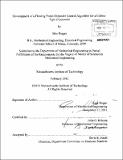| dc.contributor.advisor | John G. Brisson. | en_US |
| dc.contributor.author | Hogan, Jake (Jake R.) | en_US |
| dc.contributor.other | Massachusetts Institute of Technology. Dept. of Mechanical Engineering. | en_US |
| dc.date.accessioned | 2012-04-27T17:34:37Z | |
| dc.date.available | 2012-04-27T17:34:37Z | |
| dc.date.copyright | 2012 | en_US |
| dc.date.issued | 2012 | en_US |
| dc.identifier.uri | http://hdl.handle.net/1721.1/70459 | |
| dc.description | Thesis (S.M.)--Massachusetts Institute of Technology, Dept. of Mechanical Engineering, 2012. | en_US |
| dc.description | Cataloged from PDF version of thesis. | en_US |
| dc.description | Includes bibliographical references (p. 96). | en_US |
| dc.description.abstract | The multi-stage Collins-type cryocooler uses a floating piston design for the working fluid expansion in each stage. The piston floats between a cold volume, where the working fluid is expanded, and a warm volume. The piston's motion is controlled by opening and closing valves connecting several reservoirs at various pressures to the warm volume. Ideally, these pressures should be distributed between the high and low system pressure to gain good control of the piston motion. In past prototypes, helium flow through the piston-cylinder gap resulted in a loss of pressure in the reservoirs causing the piston to become immobile. A more complex control algorithm is required to maintain a net zero helium flow through this gap to allow for steady expander operation. A numerical quasi-steady thermodynamic model is developed for the piston cycle. The model determines the steady state pressure distribution of the reservoirs for an ideal expander with no helium flow through the piston-cylinder gap. This pressure distribution is dependent on the total mass of helium in pressure reservoirs as well as the points at which the warm helium intake as well as the cold helium exhaust end. The pressures in the pressure reservoirs show varying levels of dependence on the lengths of the intake and exhaust strokes. The model is extended to include helium flow through the gap and the inertia of the piston. The model is then used to determine how helium can be added to or removed from the reservoirs in the case that there is too much helium flow through the gap. These results are then integrated into a control algorithm that maintains zero net mass flow through the gap in each expander stage. | en_US |
| dc.description.statementofresponsibility | by Jake Hogan. | en_US |
| dc.format.extent | 128 p. | en_US |
| dc.language.iso | eng | en_US |
| dc.publisher | Massachusetts Institute of Technology | en_US |
| dc.rights | M.I.T. theses are protected by
copyright. They may be viewed from this source for any purpose, but
reproduction or distribution in any format is prohibited without written
permission. See provided URL for inquiries about permission. | en_US |
| dc.rights.uri | http://dspace.mit.edu/handle/1721.1/7582 | en_US |
| dc.subject | Mechanical Engineering. | en_US |
| dc.title | Development of a floating piston expander control algorithm for a Collins-type cryocooler | en_US |
| dc.type | Thesis | en_US |
| dc.description.degree | S.M. | en_US |
| dc.contributor.department | Massachusetts Institute of Technology. Department of Mechanical Engineering | |
| dc.identifier.oclc | 785721167 | en_US |
